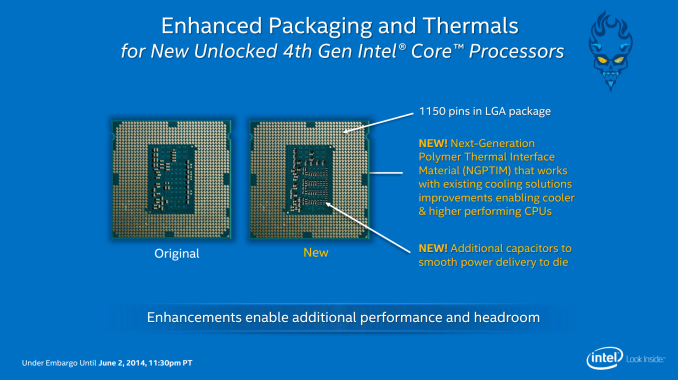Devil’s Canyon Review: Intel Core i7-4790K and i5-4690K
by Ian Cutress on July 11, 2014 10:00 AM EST- Posted in
- CPUs
- Intel
- Haswell
- i7
- Overclocking
- Devil's Canyon
- i5
- 4790K
- 4690K
Conclusions
End-users with CPU intensive workloads always feel justified in requesting for more performance. The only question is if that performance is required at the expense of power, and if the CPU company feel satisfied they can offer a higher performance component with absolute stability. Over the past three generations, Intel CPUs at equal frequency have offered a 5-10% performance boost over the previous generation, usually around the same power envelope. Because 2014 would seem to be a year where there is no major generation change for the mainstream market segment, in order to provide that 10% boost, they have had to go directly at clock speeds.
With the clock speed change, the package is also adjusted in two distinct ways. The first is to add extra decoupling capacitors on the PCB, allowing the voltage regulator on the die to deliver cleaner power to where it needs to go. The second addresses the issue of temperature, whereby the heat generated by the processor is removed. By adjusting the thermal interface material, Intel hopes to have a CPU that is ~10C cooler than the original Haswell CPUs at the same frequency and voltage. This latter part is directly observable, and even when overclocked, the ~10C temperature difference is very much visible.
This leads on to overclocking, the supposed reason for the release of Devil’s Canyon. Lisa Graff, VP and GM of Intel’s Desktop Client Platform Group, indicated in a press call before Computex that the lead design teams on Devil’s Canyon had six months to make the changes, and that the CPUs were aimed at addressing concerns levied at Intel from users who enjoy overclocking. The main concerns were the variability of the headroom of the Haswell CPU line, where some CPUs could only manage +5% whereas others gave +20% extra frequency, along with high temperatures at low clock speeds. By releasing the i7-4790K at 4.0 GHz/4.4 GHz Turbo, this ensures that the out-of-the-box i7-4790K has a better performance than the lowest performing overclocked i7-4770K CPUs. The adjustment in the thermal interface material (which we suspect is a change in the ceramic filler to an aluminum oxide or derivative therein) also gives more headroom for the i7-4790K CPUs that might have been temperature limited otherwise.
For our overclocking performance, both of our CPUs were hitting their voltage limitations as a result of the temperature adjustment. At the top end of our final overclocks, in order to adjust +100 MHz to be fully stable required a large jump of +0.100 volts, pushing the CPU voltage outside of the recommended window for a 24/7 stable Haswell-based processor. Both the i7-4790K and the i5-4690K in our testing gave 4.7 GHz benchmark stable, 100 MHz more than our first i7-4770K sample and 500 MHz more than our second i7-4770K sample.
This ends up being the main selling point for the overclocking end-user: if you own a relatively mediocre Sandy Bridge, Ivy Bridge or Haswell CPU, and have CPU limited throughput, there can be performance gains by investing into the Devil’s Canyon (CPU + Z97 motherboard or Z87 with BIOS updates) ecosystem. These are ‘enhancements’ that Intel should build on for the future, and never remove. I am sure that many enthusiasts would like to see a return to soldering the IHS on, or a single version with this feature.
For users relying on an Ivy Bridge stock system, the i7 Devil’s Canyon can offer a 17% increase over the i7-3770K for CPU benchmarks. For those that need the fastest single-thread VT-d enabled processor according to Intel's specification pages, the i7-4790K also affords that opportunity.
Users that are looking for the fastest GPU for gaming, at 1080p, might not be impressed by either the i5 or i7 Devil’s Canyon. At least in our testing, we saw no improvement from Ivy Bridge to Devil’s Canyon. One might argue that the story would be different for online gaming, or at larger resolutions, however for the latter there is more emphasis on upgrading the GPU over the CPU. While some hardware setups offer this mainstream CPU with three and four-way GPU gaming, typically we end up recommending the extreme platform due to fewer PCIe switches required.
The next question is oriented towards the future. Will the next generation of Intel CPUs perform better than Devil’s Canyon? The expected release date of Broadwell CPUs is still unknown, as is the extent of Intel's desktop offerings. Some media are expecting Broadwell to be more IGP focused as a platform, given the initial expectations of no desktop parts. To put this into perspective: if Broadwell offers a 5-10% IPC increase, Intel has to offer a 4.0 GHz / 4.4 GHz Turbo version in order to make their fastest mainstream processor even faster. However, given the history of Intel’s releases, if they release a top end i7, it will most likely be a 3.6 GHz / 4.0 GHz Turbo part, and offer the same performance as Devil’s Canyon. We cannot predict the overclocking potential, or if Intel is going to migrate the ‘enhanced overclocking features’ of Devil’s Canyon to the new parts. If this is the case, Intel will have to offer a new 'feature' to help sell the new high end parts.
The user has to hedge their bets – when is Broadwell coming to market, and is there going to be a large OC version of Broadwell, the equivalent of Devil’s Canyon is to Haswell? We are currently looking at 5 months away from Broadwell-Y (also known as Core-M) based on Intel announcements but no indication yet when Broadwell-DT is released, meaning an investment in Devil’s Canyon gives the top class mainstream processor based system until then.
The next piece of the puzzle is Haswell-E where many sources, such as CPU-World, are quoting that the low end SKU (an i7-5820K going by previous naming schemes) will be a six-core 3.3 GHz CPU with some amount of turbo. Historically Intel has charged roughly the same amount for the lowest Enthusiast CPU and the top Mainstream CPU, although this time the lowest Enthusiast CPU will have two more cores. So until Haswell-E is released, along with DDR4 and the X99 chipset, Devil’s Canyon might sit in the ‘should I wait’ category. But if we were looking at upgrading that main system today, based on CPU limited workloads, the i7-4790K is a well recommended choice.














117 Comments
View All Comments
ZeDestructor - Friday, July 11, 2014 - link
Couldn't you use something with a dedicated server combined with kb/mouse emulation on a bunch of extra PCs running at 640x480 nonsense kind of thing?It's potentially more work, especially the potential synchronisation and timing issues, but it should be doable to within 10ms of latency (on my LAN I see ping roundtrips in the sub-ms range), should it not?
Ryan Smith - Friday, July 11, 2014 - link
In theory yes. But in practice most first-person games spawn you at a random point, which makes any kind of input track playback ineffective.The games where such a thing would work would tend to be games that already have better benchmark capabilities anyhow, such as racers and RTSes.
ZeDestructor - Friday, July 11, 2014 - link
Couldn't you get a modified DS from a dev?FlushedBubblyJock - Thursday, November 20, 2014 - link
They just don't want to do it.They live for their claimed accurate scientific method.
It will take a genius with guts or a brute with some money, then we can see the results we never get that we all want somewhere else.
Let's face it, it could be done and there would be some +/- low end percentage variability, so frames could be rounded to whole numbers removing the tenths ( which are outside the current bench errors and variability ).
It just isn't going to happen here, but someone should definitely do it, and we'd all love going there.
Real life scenarios are just too scary for the cold and removed and protected elite. Politics.
We all play our online games and know what frames we can count on given our vid cards and systems and current clocks and we all have our favorite maps and servers... etc.
Remember all these websites run the highest end overlcocked cpu and boards they possibly can, and that also is deceptive for most readers.
They run SSD's now with clean installs and used to go with defragged and rebooted but now methods are equivalent so nothing extra is running best case scenario stuff...
Yes another type of review site is needed, but then again the general idea is given for what info is available here, so downsize accordingly is the answer.
wallysb01 - Sunday, July 13, 2014 - link
If this is something that’s really needed for a real test, why not just do it 50 times per processor and do some stats.doggghouse - Friday, July 11, 2014 - link
Out of curiosity, what do people consider to be safe voltages for Haswell? I recently had to replace my 4770K with a 4790K because the chip started to BSOD even when not overclocked... I don't know if I helped speed its demise after having tested it at 1.4V several times, and I think I settled on 1.3V 4.4GHz daily use (it was a mediocre chip apparently).I apparently lucked out on my 4790K because it is running stable at 4.6GHz with only 1.25V, and 4.7GHz at 1.3125V. I was thinking about testing its upper limits for fun--try for the mythical 5GHz--but I don't want to accidentally burn out an otherwise great chip. I very briefly ran it at 5GHz with 1.424V and HT disabled, it was stable enough to run a few benchmarks. But if I play around in the 1.4V range, am I potentially going to wreck it?
TheinsanegamerN - Saturday, July 12, 2014 - link
Typically, for 22nm intel (sandy bridge and haswell) the typically regarded "safe 24/7 voltage" is only 1.3 volt on air, and 1.4 volt on water. for a very short period, higher than 1.4 can be used if you have VERY good cooling, but you may damage the vhip even with ln2 cooling at anything above 1.4v.Also, it sucks you had to do 1.3v to get to 4.4Ghz....I hit 4.2Ghz at only 1.075v. apparently got a REALLY good chip somehow, although i heard that the costa rica chips, of which mine is one, always did overclock better.
doggghouse - Monday, July 14, 2014 - link
Interesting... so is it the temps, and not the voltage directly, that eventually kills the chip? If so, would running lots of synthetic benchmarks that brings temps into the 90-100C range shorten its lifespan? I have an AIO water cooler, the Kraken X60, which can keep normal temps cool, but anything above 1.25V will still hit 100C on the latest Prime95 Small FFTs test.FlushedBubblyJock - Thursday, November 20, 2014 - link
Voltage can kill the cpu. You won't necessarily get the temp reading it can happen so fast.Secondarily, a higher voltage is more volatile with higher temps, so the combination can also cause electromigration blowouts.
Dustin Sklavos - Friday, July 11, 2014 - link
"A contact at Corsair.";)
Here are the complete results for my Devil's Canyon and Pentium chips:
4790K #1: 4.7GHz @ 1.275V
4790K #2: 4.7GHz @ 1.31V
4690K #1: 4.7GHz @ 1.375V
4690K #2: 4.8GHz @ 1.375V
G3258 #1: 4.9GHz @ 1.4V
G3258 #2: 4.7GHz @ 1.375V